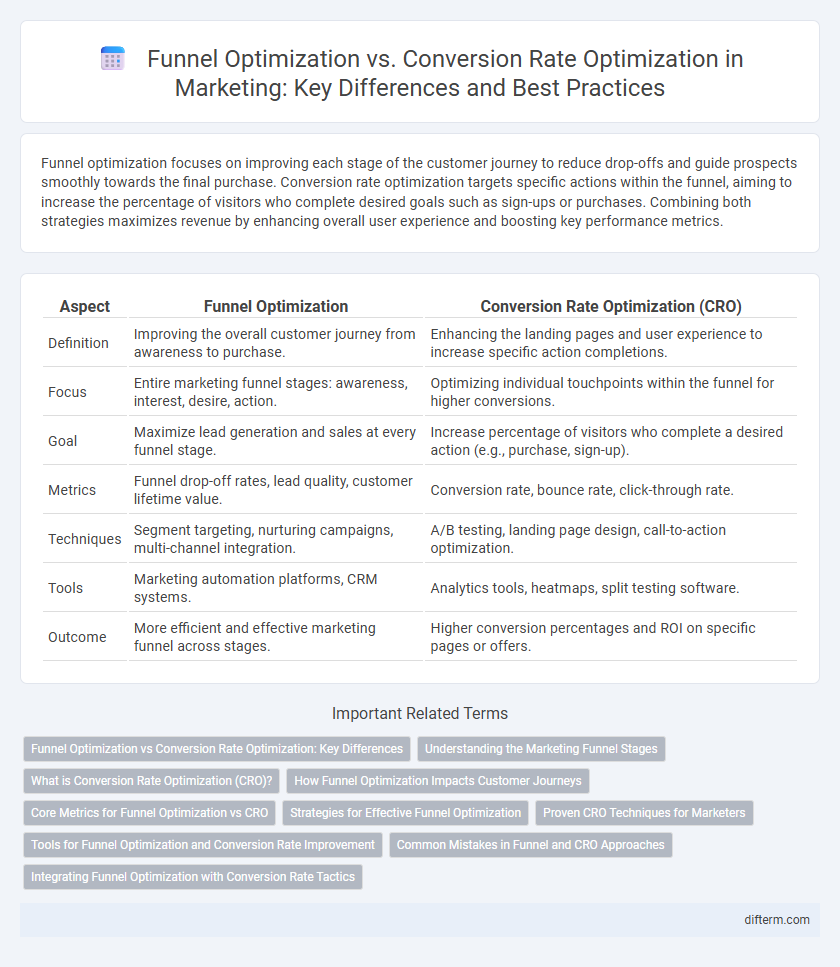Funnel optimization focuses on improving each stage of the customer journey to reduce drop-offs and guide prospects smoothly towards the final purchase. Conversion rate optimization targets specific actions within the funnel, aiming to increase the percentage of visitors who complete desired goals such as sign-ups or purchases. Combining both strategies maximizes revenue by enhancing overall user experience and boosting key performance metrics.
Table of Comparison
| Aspect | Funnel Optimization | Conversion Rate Optimization (CRO) |
|---|---|---|
| Definition | Improving the overall customer journey from awareness to purchase. | Enhancing the landing pages and user experience to increase specific action completions. |
| Focus | Entire marketing funnel stages: awareness, interest, desire, action. | Optimizing individual touchpoints within the funnel for higher conversions. |
| Goal | Maximize lead generation and sales at every funnel stage. | Increase percentage of visitors who complete a desired action (e.g., purchase, sign-up). |
| Metrics | Funnel drop-off rates, lead quality, customer lifetime value. | Conversion rate, bounce rate, click-through rate. |
| Techniques | Segment targeting, nurturing campaigns, multi-channel integration. | A/B testing, landing page design, call-to-action optimization. |
| Tools | Marketing automation platforms, CRM systems. | Analytics tools, heatmaps, split testing software. |
| Outcome | More efficient and effective marketing funnel across stages. | Higher conversion percentages and ROI on specific pages or offers. |
Funnel Optimization vs Conversion Rate Optimization: Key Differences
Funnel optimization focuses on improving the entire customer journey from awareness to purchase, identifying drop-off points and enhancing each stage for smoother progression. Conversion rate optimization (CRO) emphasizes increasing the percentage of visitors who complete a specific action, such as signing up or buying, by optimizing individual touchpoints like landing pages or call-to-action buttons. Understanding the key differences between funnel optimization and CRO helps marketers tailor strategies to boost overall sales and user engagement effectively.
Understanding the Marketing Funnel Stages
Marketing funnel stages include awareness, consideration, and decision, each representing a critical point where potential customers engage differently. Funnel optimization focuses on improving the flow and drop-off rates across these stages to guide prospects smoothly toward purchase. Conversion rate optimization (CRO) targets enhancing the effectiveness of specific actions or pages within these stages to maximize the percentage of visitors completing desired goals.
What is Conversion Rate Optimization (CRO)?
Conversion Rate Optimization (CRO) is the systematic process of increasing the percentage of website visitors who complete a desired action, such as making a purchase or filling out a form. It involves analyzing user behavior, conducting A/B testing, and refining website elements like call-to-action buttons, landing pages, and content to enhance user experience and drive higher conversion rates. CRO focuses specifically on turning traffic into leads or customers, whereas funnel optimization looks at the broader customer journey from awareness to retention.
How Funnel Optimization Impacts Customer Journeys
Funnel optimization systematically improves each stage of the customer journey, from awareness to purchase, ensuring a smoother progression through marketing channels. By identifying friction points and optimizing touchpoints, businesses enhance engagement and reduce drop-offs, resulting in increased sales and customer retention. This targeted approach drives a more efficient funnel that delivers higher-quality leads and boosts overall conversion rates.
Core Metrics for Funnel Optimization vs CRO
Funnel optimization focuses on improving user progression through each stage of the marketing funnel, emphasizing core metrics like drop-off rates, time spent per stage, and lead velocity to identify leaks and bottlenecks. Conversion rate optimization (CRO) prioritizes enhancing the percentage of visitors who complete a desired action, using metrics such as overall conversion rates, A/B test results, and click-through rates to refine landing pages and calls-to-action. Both strategies rely on data-driven analysis but differ in scope, with funnel optimization targeting the entire customer journey and CRO zeroing in on specific conversion points.
Strategies for Effective Funnel Optimization
Effective funnel optimization strategies focus on mapping the entire customer journey to identify and eliminate drop-off points, enhancing user experience and engagement at each stage. Data-driven segmentation and personalized content enable targeted messaging that resonates with specific audience segments, boosting progression through the funnel. Continuous A/B testing, coupled with analytics tracking, refines touchpoints and streamlines transitions from awareness to purchase, maximizing overall funnel efficiency.
Proven CRO Techniques for Marketers
Funnel optimization targets the entire customer journey to identify and eliminate drop-off points, enhancing overall engagement and lead nurturing. Proven conversion rate optimization (CRO) techniques focus on A/B testing, personalized content, and persuasive CTAs to boost specific actions like sign-ups or purchases. Marketers leveraging data-driven insights and behavioral analytics achieve higher ROI by integrating both strategies effectively.
Tools for Funnel Optimization and Conversion Rate Improvement
Funnel optimization tools like Google Analytics, Hotjar, and ClickFunnels enable detailed tracking of user behavior and drop-off points to refine each stage of the marketing funnel. Conversion rate improvement platforms such as Optimizely, VWO, and Unbounce offer A/B testing, heatmaps, and personalization features that directly enhance landing page effectiveness and boost conversion metrics. Integrating these tools provides marketers with comprehensive insights and actionable data to maximize lead generation and revenue growth.
Common Mistakes in Funnel and CRO Approaches
Common mistakes in funnel optimization include neglecting audience segmentation and failing to analyze drop-off points accurately, which lead to inefficient targeting and lost prospects. In conversion rate optimization (CRO), errors often involve focusing solely on A/B testing without addressing deeper user experience issues or misinterpreting data signals. Both approaches require continuous data-driven adjustments and clear alignment between marketing goals and user behavior insights to maximize performance.
Integrating Funnel Optimization with Conversion Rate Tactics
Integrating funnel optimization with conversion rate tactics enhances overall marketing performance by aligning customer journey stages with targeted conversion strategies. Utilizing data-driven insights to identify drop-off points within each funnel phase enables precise adjustments that increase lead quality and sales velocity. Combining funnel analysis with A/B testing and personalized content improves both user experience and conversion rates, maximizing ROI across marketing campaigns.
Funnel optimization vs conversion rate optimization Infographic

 difterm.com
difterm.com